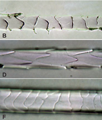Cuticular and medullar microstructure of the guard hair of small land mammals in the region of Arequipa, Peru
DOI:
https://doi.org/10.15381/rpb.v26i1.15909Keywords:
Cuticle; mammal; marsupial; marrow; rodent.Abstract
Currently, the study of guard hairs is used in various areas of basic and applied sciences (taxonomy, ecology, genetics, paleontology, criminology, among others), due to its resistance to physical, chemical, mechanical and biological factors, conserving its cuticular and medullar structure. These structures form patterns that allow the identification of specimens at the level of genera and families. However, despite the importance, there are no studies on this subject in Peru. Therefore, samples from 30 mammalian species of Didelphimorphia and Rodentia were examined to fill this information gap. Among the species studied, we differentiated 5 medullary and 8 cuticular patterns. The didelphid marsupials have a medial uniseriate scaleriform pattern with a foliaceous cuticular pattern; the cricetid rodents have an alveolar multiseriate medullary pattern and a foliate cuticular pattern, the chinchillids a reticular medullary pattern with a cuticular pattern of diamond petal type D, the caviids a reticular medullary pattern with a transverse cuticular pattern, the abrocomids a medullary pattern listrade with simple oblique wave cuticular pattern, and the murids a reticular and alveolar medullary pattern with cuticular pattern petal diamond (type B and C) or foliaceous. We present for the first time the detailed description of the cuticle and marrow of the guard hairs of 24 species of rodents and 2 marsupials.
Downloads

Downloads
Published
Issue
Section
License
Copyright (c) 2019 Yasmy K. Medina, César E. Medina, Evaristo López

This work is licensed under a Creative Commons Attribution-NonCommercial-ShareAlike 4.0 International License.
AUTHORS RETAIN THEIR RIGHTS:
a. Authors retain their trade mark rights and patent, and also on any process or procedure described in the article.
b. Authors retain their right to share, copy, distribute, perform and publicly communicate their article (eg, to place their article in an institutional repository or publish it in a book), with an acknowledgment of its initial publication in the Revista Peruana de Biologia.
c. Authors retain theirs right to make a subsequent publication of their work, to use the article or any part thereof (eg a compilation of his papers, lecture notes, thesis, or a book), always indicating its initial publication in the Revista Peruana de Biologia (the originator of the work, journal, volume, number and date).

















